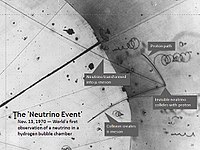
Photo from wikipedia
A bstractMinimal SO(10) grand unified models provide phenomenological predictions for neutrino mass patterns and mixing. These are the outcome of the interplay of several features, namely: i) the seesaw mechanism;… Click to show full abstract
A bstractMinimal SO(10) grand unified models provide phenomenological predictions for neutrino mass patterns and mixing. These are the outcome of the interplay of several features, namely: i) the seesaw mechanism; ii) the presence of an intermediate scale where B-L gauge symmetry is broken and the right-handed neutrinos acquire a Majorana mass; iii) a symmetric Dirac neutrino mass matrix whose pattern is close to the up-type quark one. In this framework two natural characteristics emerge. Normal neutrino mass hierarchy is the only allowed, and there is an approximate relation involving both light-neutrino masses and mixing parameters. This differs from what occurring when horizontal flavour symmetries are invoked. In this case, in fact, neutrino mixing or mass relations have been separately obtained in literature. In this paper we discuss an example of such comprehensive mixing-mass relation in a specific realization of SO(10) and, in particular, analyse its impact on the expected neutrinoless double beta decay effective mass parameter 〈mee〉, and on the neutrino mass scale. Remarkably a lower limit for the lightest neutrino mass is obtained (mlightest ≳ 7.5 × 10−4 eV, at 3 σ level).
Journal Title: Journal of High Energy Physics
Year Published: 2017
Link to full text (if available)
Share on Social Media: Sign Up to like & get
recommendations!